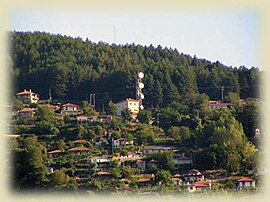| Revision as of 20:41, 20 November 2011 editMarkussep (talk | contribs)Autopatrolled, Extended confirmed users, Page movers, Pending changes reviewers, Template editors557,600 editsm periphery --> region using AWB← Previous edit |
Revision as of 15:35, 30 January 2012 edit undoMarkussep (talk | contribs)Autopatrolled, Extended confirmed users, Page movers, Pending changes reviewers, Template editors557,600 edits cleanupNext edit → |
| Line 23: |
Line 23: |
|
|caption_skyline = |
|
|caption_skyline = |
|
}} |
|
}} |
|
|
'''Granitsa''' ({{lang-el|Γρανίτσα}}) is a mountain village and a community in ], ]. It is situated at 720 meters elevation, on a mountain slope above the river ]. It is built in the forested lower regions of ]. Granitsa was the seat of the municipality of ]. The community consists of the villages Granitsa, Ano Potamia, Kato Potamia and Armampela. The village preserves its old appearance. It is 32 kilometers northwest of ]. |
| ⚫ |
'''Granitsa''' ({{lang-el|Γρανίτσα Ευρυτανίας, ''Granitsa Evrytanias''}}) is a mountain village in the ] prefecture located at 850 meters of altitude. It is built into the forested downhill regions of ] next to the ]. It also offers views of the Granitsiotis valley and the mountain. Granitsa was the seat of the municipality of ]. The village preserves its old appearance and it is 82 kilometers northwest from ]. It is the birthplace of artists such as ], ], and ]. It is also the home of ], who became a martyr after he was killed in 1544. Granitsa had seventeen churches, most of which were destroyed during ] rule. It is worth visiting the Folklore Museum which contains popular art such as woven objects, carved wooden objects, rural cattle-raising tools, a loom, local clothes and weapons from the ]. The museum also contains portraits and personal belongings of individuals such as ] and Stefanos Granitsas, paintings of the popular local painters ] and ] and the personal book collection of Zacharias Papantoniou. Other notable sights are the remaining nine churches of the village. They were built in different time periods. |
|
|
|
|
|
|
⚫ |
Granitsa is the birthplace of artists such as ], ], and ]. It is also the home of ], who became a martyr after he was killed in 1544. Granitsa had seventeen churches, most of which were destroyed during ] rule. It has a Folklore Museum which contains popular art such as woven objects, carved wooden objects, rural cattle-raising tools, a loom, local clothes and weapons from the ]. The museum also contains portraits and personal belongings of individuals such as ] and Stefanos Granitsas, paintings of the popular local painters ] and ] and the personal book collection of Zacharias Papantoniou. Other notable sights are the remaining nine churches of the village. |
|
==Subdivisions== |
|
|
|
|
|
*] |
|
|
*] |
|
|
*] |
|
|
*] |
|
|
*] |
|
|
*] |
|
|
*] |
|
|
|
|
|
==Information== |
|
|
The main local products are fruits including watermelon, melon, figs and vegetables such as corn, tomatoes, potatoes, onions and cucumbers as well as dairy, livestock, olives and others. The majority of the population work in businesses as well as agriculture. |
|
|
|
|
|
Houses were stone-built until the 1950s and did not surpass modern-style homes until the 1980s. They were linked with pavement in the 1980s. Most of the homes are abandoned today. |
|
|
|
|
|
After ] and the ], much of the population left for larger towns and cities. The population declined between the 1981 and the 1991 census but nearly doubled between the 1991 and the 2001 censuses. |
|
|
|
|
|
|
==Population== |
|
==Population== |
|
|
|
|
|
|
{| class="wikitable" |
|
{| border="1" cellpadding="2" cellspacing="0" |
|
|
⚫ |
! Year !! Village population !! Community population |
|
|- bgcolor="#efefef" |
|
| ⚫ |
! Year !! Village population !! Municipal district population |
|
|
|- |
|
|- |
|
| 1981 || 601 || - |
|
| 1981 || - || 601 |
|
|- |
|
|- |
|
| 1991 || 360 || - |
|
| 1991 || 360 || - |
| Line 63: |
Line 47: |
|
==See also== |
|
==See also== |
|
|
|
|
|
*] |
|
*] |
|
|
|
|
|
==External links== |
|
==External links== |
|
* |
|
|
* |
|
* |
|
|
|
|

